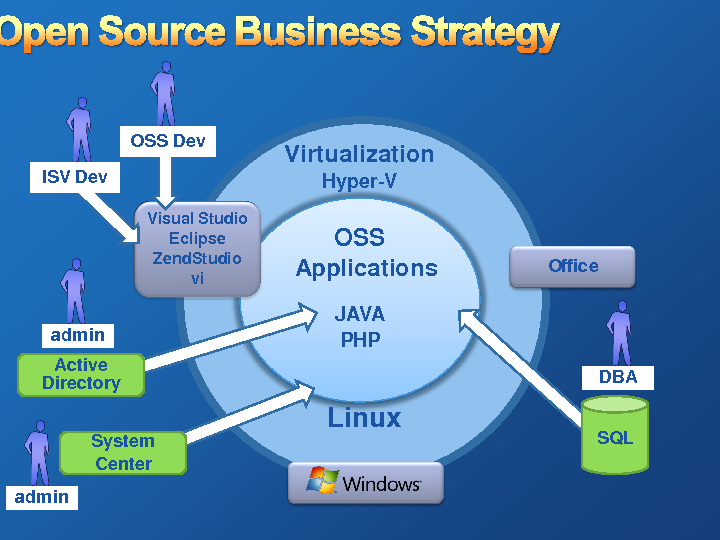Microsoft's Embrace and Extend strategy for Open Source
By Roberto Di Cosmo on Sunday, April 6 2008, 10:06 - Informatique et Société - Permalink
If you follow the OSS news, it will be difficult not to have noticed the long list of agreements between software companies in the Open Source world, and Microsoft.
Is it a sign that Microsoft has seen the light? Is Microsoft going to change its monopolistic and anticompetitive behavior? Is the battle over, and Open Source has won?
I do not think so: Microsoft has a very precise strategy in mind, which is, on top of it, not particularly new.
Unfortunately, I still have found not a single decent analysis of their strategy on the web, or the professional press, and I have to say that in the F/OSS community some people seem too keen to congratulate themselves for passing agreements with this juggernaut, to take the time to sit down and look at what they really have agreed to.
So, I think it's time to give a different point of view. Ready? Let's go!
Last January, I was giving a talk in a session at the Solutions Linux event in Paris, and I had the occasion to listen to a presentation from Tom Hanrahan, one of the new OSS gurus at Microsoft.
One of the slides he showed was particularly enlightening for somebody used to decrypt Microsoft's strategy, and it was immediately evident to me what Microsoft, this formerly declared deadly enemy of Open Source, is doing.

Right on the picture, you can see a trace of the latest and greatest deals struck by Microsoft with companies from the Open Source ecosystem:
- Microsoft and Novell's deal included cooperation on virtualization: in particular, their common work is targeted to make sure that Linux can run seamlessly as a virtual system on top of Windows (not necessarily all version of Windows, though);
- Microsoft and Zend's deal will bring improvements to the integration of PHP with Windows-only software services, like the one found in Active directory, and SQL server;
- Microsoft is working with people from Eclipse to improve interoperability between software built around Eclipse and the Windows platform;
- ...
Well, let's think a bit about what is happening here: we all know the success of LAMP systems, mixing GNU/Linux, Apache, MySQL and PHP to provide quick and cheap dynamic web sites to the masses: no licences to pay, full access to the source code, almost from the transistor level up to the final software application, a large base of available documentation and code examples. Your Open Source software-based solution, which is actually the nice blue aerostatic balloon in the picture above, soars, thrives and takes off, and you stop paying monopoly taxes to legacy proprietary software providers.
And now, here comes the legacy proprietary software provider, spending large amounts of money to be able to approach you proposing to extend your user experience by adding access to Active Directory, SQL server, and other nifty expensive closed solutions, easily accessible and integrate right in the middle of the development tools you are used to: did you notice the green boxes in the picture above? Right, there they are! You are not obliged to use them; but since the functionality is there, well embedded in the tools, you might end up doing so not even knowing it, and then your applications will start depending on them.
As a final step, you are offered to run your Open Source software world right on top of a well weighted Windows operating system. But why in the wolrd would you want to run a virtualized GNU/Linux distribution on top of a Windows server? ISPs have beeing going exactly the other way for years, and the new Asus motherboards do exactly the contrary (fast boot of an embedded Linux out of the flash, first, then we'll see)!
If you think a bit, the picture above is pretty clear: you see a nice light blue Open Source balloon, ready to take off, and you can see all the green weigths that are being attached to it, to keep it from flying, and keep it stuck to that grey block with flying windows stuck on it.
That's just, again, the old "embrace and extend" strategy, rolled out in a new incarnation from the very experts in the field.
We cannot, of course, blame Microsoft for trying to use commercial agreements to piggyback on the Open Source lifting power, but we can ask people from the Open Source world to think a bit more about their priorities: they might find it motivating to spend part of their precious time to make their Open Source software easier to use on the Windows platform, but is it really necessary to start with that part of the work which is more likely to irremediably tangling the Open Source infrastructure to closed proprietary solutions from the oldest and greatest enemy of Free Software of all?